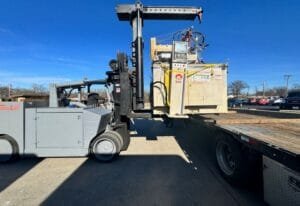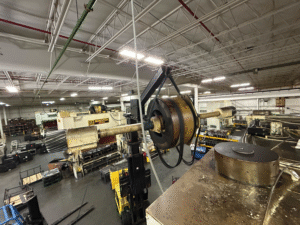Choosing the right method for moving heavy equipment is critical for ensuring safety, efficiency, and cost-effectiveness. The process involves assessing various factors, including the type of equipment, distance, terrain, and specific logistical requirements. This comprehensive guide will help you navigate the different heavy equipment moving methods and make an informed decision.
Understanding Heavy Equipment Moving Methods
There are several methods for moving heavy equipment, each with its own advantages and considerations. The main methods include:
- Flatbed Trucking
- Towing
- Crane Lifting
- Heavy Haul Trailers
- Rail Transport
- Air Transport
- Water Transport
Let’s delve into each method, exploring when and why they are used, their benefits, and potential drawbacks.
Flatbed Trucking
Flatbed trucking is one of the most common methods for moving heavy equipment. It involves loading equipment onto a flatbed trailer, which is then hauled by a truck.
Benefits
- Versatility: Suitable for a wide range of equipment sizes and types.
- Accessibility: Can be used for local, regional, and national transport.
- Cost-Effective: Generally more affordable than specialized transport methods.
Considerations
- Size and Weight Limits: Must adhere to weight and dimension regulations.
- Loading and Unloading: Requires appropriate equipment for safe loading and unloading.
When to Use
Flatbed trucking is ideal for transporting equipment that can be easily loaded and secured on a flat surface, such as construction machinery, vehicles, and industrial equipment.
Towing
Towing involves attaching the equipment to a tow vehicle using a tow hitch or specialized towing apparatus.
Benefits
- Simple and Quick: Suitable for short distances and quick relocations.
- Low Cost: Generally less expensive than other methods.
Considerations
- Distance Limitations: Best for short-distance moves.
- Equipment Condition: Suitable for equipment that can be safely towed without risk of damage.
When to Use
Towing is perfect for moving smaller heavy equipment, such as vehicles or small machinery, over short distances, like within a construction site or between nearby locations.
Crane Lifting
Crane lifting involves using cranes to lift and move heavy equipment, particularly for vertical movements or navigating obstacles.
Benefits
- Precision: Allows for precise placement and movement.
- Vertical Movement: Ideal for lifting equipment to or from elevated positions.
Considerations
- Cost: Can be expensive due to equipment and operator costs.
- Setup Time: Requires time to set up and dismantle the crane.
When to Use
Crane lifting is essential for moving heavy equipment in environments with vertical challenges, such as construction sites with high-rise buildings or industrial facilities with complex layouts.
Heavy Haul Trailers
Heavy haul trailers are specialized trailers designed to carry extremely heavy and oversized equipment.
Benefits
- High Capacity: Can handle very large and heavy loads.
- Specialized Design: Equipped with features like adjustable axles and reinforced structures.
Considerations
- Permits and Regulations: Requires special permits and adherence to stringent regulations.
- Cost: Typically more expensive due to specialized nature.
When to Use
Heavy haul trailers are suitable for transporting oversized or extremely heavy equipment, such as large industrial machinery, power plant components, or construction vehicles.
Rail Transport
Rail transport involves moving heavy equipment via train, using specialized rail cars designed for heavy loads.
Benefits
- Efficiency for Long Distances: Ideal for long-haul transport.
- Cost-Effective for Large Volumes: Economical when moving large quantities of equipment.
Considerations
- Accessibility: Requires access to rail infrastructure.
- Loading and Unloading: Can be complex and time-consuming.
When to Use
Rail transport is ideal for moving heavy equipment over long distances, particularly when transporting large volumes of equipment to destinations accessible by rail.
Air Transport
Air transport involves using cargo planes to move heavy equipment, offering the fastest mode of transportation.
Benefits
- Speed: Fastest method for long-distance transport.
- Global Reach: Can transport equipment internationally with ease.
Considerations
- Cost: Extremely expensive due to high operational costs.
- Size and Weight Limits: Limited by aircraft capacity.
When to Use
Air transport is suitable for urgent shipments of heavy equipment that need to reach distant or international destinations quickly, such as time-sensitive industrial machinery or emergency relief equipment.
Water Transport
Water transport uses ships and barges to move heavy equipment, especially for international and intercontinental transport.
Benefits
- High Capacity: Can carry extremely large and heavy loads.
- Cost-Effective for Large Volumes: Economical for transporting large quantities over long distances.
Considerations
- Speed: Slower than air and land transport.
- Port Accessibility: Requires access to ports and suitable loading/unloading facilities.
When to Use
Water transport is ideal for moving heavy equipment over long distances internationally, particularly when time is less critical and cost efficiency is a priority.
Factors to Consider When Choosing a Moving Method
Choosing the right heavy equipment moving method depends on several factors:
Equipment Size and Weight
- Determine Dimensions: Measure the dimensions and weight of the equipment to ensure compatibility with the chosen transport method.
- Check Regulations: Verify that the equipment complies with legal size and weight limits for transport.
Distance and Route
- Assess Distance: Consider the distance the equipment needs to be moved and choose a method suitable for that range.
- Evaluate Route: Analyze the route for obstacles, road conditions, and accessibility to determine the best method.
Cost
- Budget Constraints: Evaluate the costs associated with each method and align with your budget.
- Hidden Costs: Be aware of additional costs such as permits, escorts, and specialized equipment.
Time Sensitivity
- Urgency: Determine the urgency of the move and select a method that meets your timeline.
- Scheduling: Consider the availability of transport services and scheduling flexibility.
Safety and Security
- Risk Assessment: Evaluate the risks involved with each method and choose the safest option.
- Insurance: Ensure the method chosen provides adequate insurance coverage for potential damage or loss.
Terrain and Environmental Conditions
- Terrain Type: Consider the terrain the equipment will traverse and choose a method that can handle it.
- Weather Conditions: Plan for potential weather impacts and select a method that mitigates these risks.
Regulatory Requirements
- Permits and Regulations: Ensure compliance with all regulatory requirements, including permits, escorts, and route approvals.
- Documentation: Prepare all necessary documentation for legal and regulatory compliance.
Steps to Choose the Right Moving Method
- Step 1: Assess Your Equipment
Start by thoroughly assessing the equipment you need to move. Take note of its dimensions, weight, and any special handling requirements. - Step 2: Define the Move Parameters
Clearly define the parameters of your move, including the origin and destination, distance, and preferred timeline. - Step 3: Evaluate Moving Methods
Review the available moving methods and evaluate them based on the factors outlined above. Create a comparison chart to visualize the pros and cons of each method. - Step 4: Consult with Experts
Seek advice from professionals in the heavy equipment moving industry. They can provide valuable insights and recommendations based on their experience. - Step 5: Get Quotes
Request quotes from multiple service providers for the moving methods you are considering. Compare costs, services, and timelines to make an informed decision. - Step 6: Plan and Schedule
Once you have chosen a moving method, plan the move in detail. Coordinate with the service provider, obtain necessary permits, and schedule the move to ensure a smooth process. - Step 7: Prepare for the Move
Prepare your equipment for the move by securing loose parts, protecting sensitive components, and ensuring it is ready for transport. Communicate with the moving team to ensure everyone is on the same page. - Step 8: Execute and Monitor
During the move, closely monitor the process to ensure everything goes according to plan. Stay in contact with the moving team and be ready to address any issues that may arise. - Step 9: Post-Move Review
After the move, review the process to identify any areas for improvement. Assess the performance of the moving method and the service provider to inform future moves.
Conclusion
Choosing the right method for moving heavy equipment is crucial for ensuring the safety, efficiency, and cost-effectiveness of the process. By understanding the different moving methods, evaluating key factors, and following a systematic approach, you can make an informed decision that meets your specific needs. Whether it’s flatbed trucking for local moves, crane lifting for vertical challenges, or rail transport for long-distance hauls, selecting the appropriate method will help you achieve a successful heavy equipment move.













